The Range extender solution we introduce exerts no fluctuating forces or moments on the motor mount. The system operates in a state of neutrality, impacting the engine mount solely through its weight. Consequently, this Range Extender technology experiences no vibrations during startup or shutdown and effectively eliminates vibrations across the entire speed spectrum.
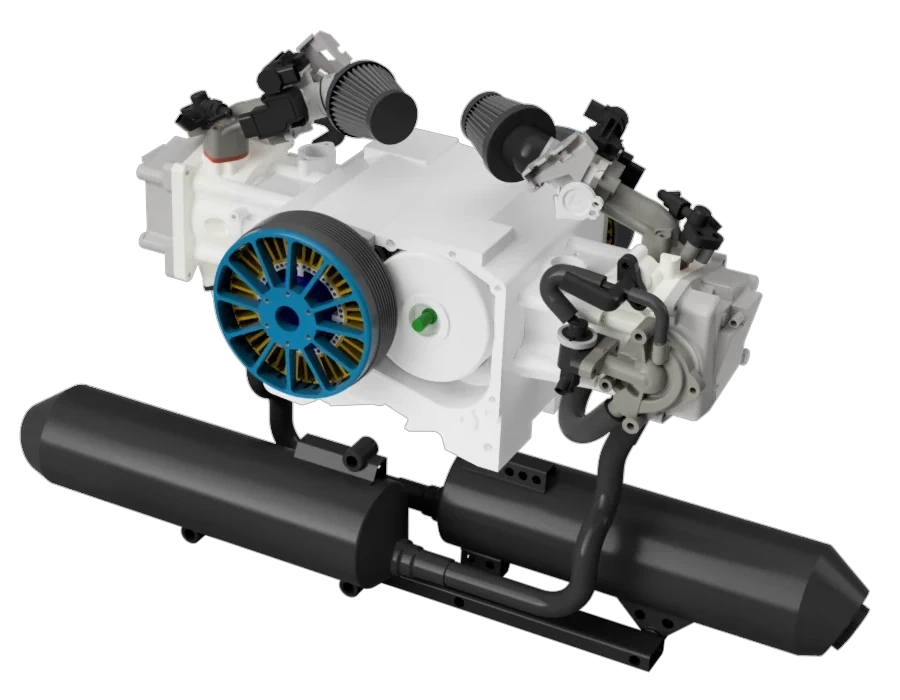
Characteristic of the Range extender
The Range extender solution we’re presenting is the outcome of extensive work to meet the requirements for creating a recharging motor-generator, often called a ‘range extender’ designed for electric aircraft.
Our primary objective was to address two essential requirements:
- Vibration Minimization: The foremost requirement centered on the elimination of vibration originating from the power unit. These vibrations are transmitted to the aircraft’s frame, and this becomes especial critical to the necessity of accommodating highly precise optical instruments.
- Weight and Dimension Reduction: The second key objective involved minimizing the weight and dimensions of the motor-generator.
A Brief Analysis of the Vibrations
In the realm of combustion engines with a single-crankshaft mechanism, we have identified two principal sources of vibrations. The first source arises from the dynamic movement of the crankshaft mechanism, while the second results from fluctuating torque during the combustion cycle.
The First Vibration Source : Inertial Forces from Crank Mechanism Motion
These vibrations are a consequence of inertial forces and their moment of force generated by the movement of crank mechanism components. For instance, consider the piston, which undergoes a reciprocating cyclic motion along a linear path, with variations in its motion speed during the cycle, or the connecting rod follows a general planar motion. In both these cases, the change in speed, direction, and acceleration gives rise to inertial forces. If these forces are not compensated within the engine through a suitable balancing system, they transmit through the engine block and engine mount to the aircraft’s chassis, leading to undesirable vibrations.
Balancing the inertial forces of the crank mechanism is a complex challenge that has been extensively documented since the inception of machines featuring crank mechanisms. Thus, we won’t delve into further detail, given the extensive prior discourse on the topic.
In conventional combustion engine design, it is customary to balance the first harmonic components of inertial forces, and, in certain cases, to balance both the first and second harmonic of inertial forces. While this balance is not perfect, it suffices for most applications, as the vibrations resulting from the combustion process in the engine cylinders far outweigh those from the third and other harmonic components of inertial forces.
The Second Vibrations Source: Combustion Cycle-Inducted Torque Fluctuation
In contrast to electric motors, an internal combustion engine introduces notable challenges related to fluctuating torque. Energy transfer to the output shaft is not uniform, resulting in considerable instantaneous torque fluctuations. Alongside inertial forces, the crank mechanism is subjected to forces originating from combustion gas within the cylinder, culminating in a fluctuating output torque.
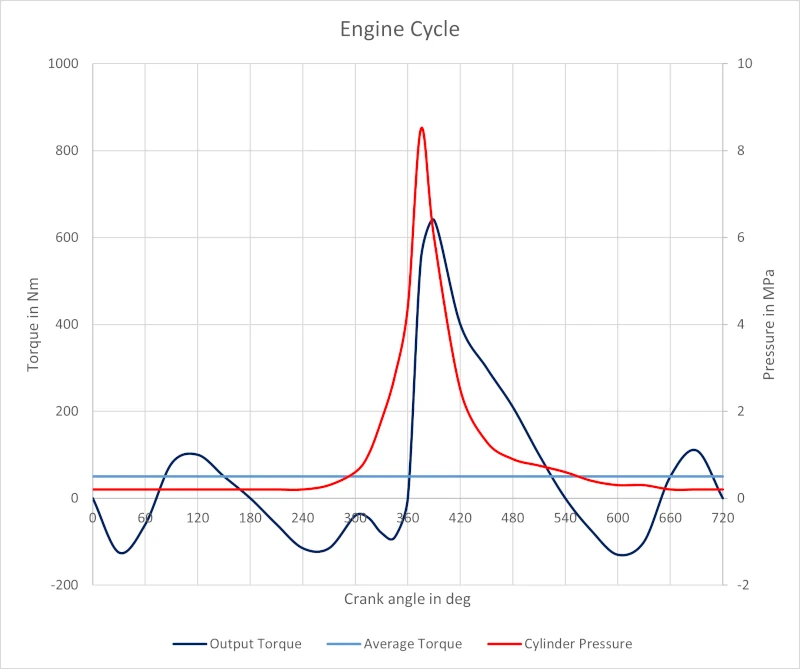
In the provided chart, the red line signifies gas pressure in the cylinder, while the dark blue line represents the resulting torque of a single-cylinder engine. The light blue line denotes the mean torque value, corresponding to the power generated throughout a full combustion cycle.
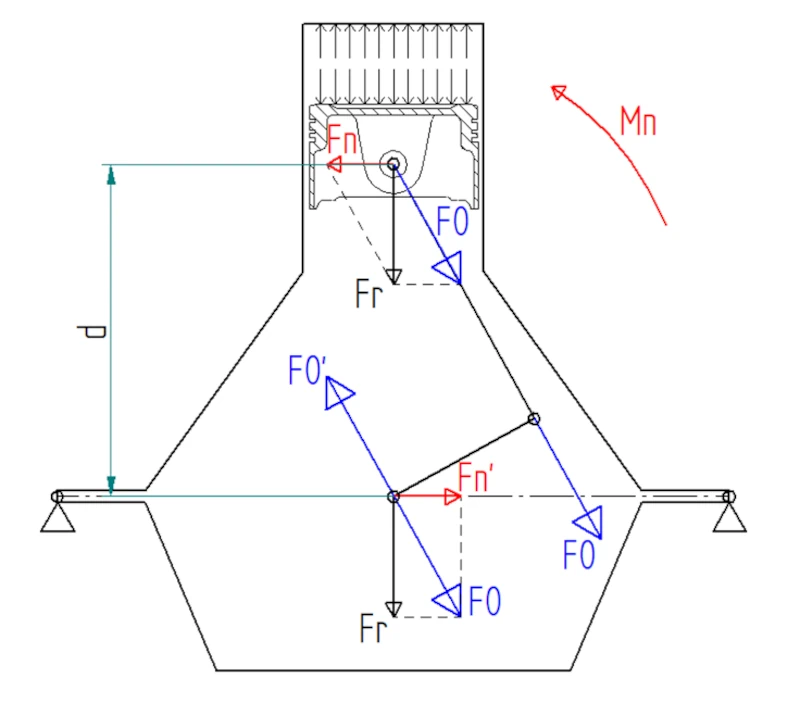
During the operation of an internal combustion engine, a tilting moment is generated as a result of the force pair (Fn) and (Fn’) acting upon the engine block in each cycle. This tilting moment’s intensity is primarily contingent on the combustion pressure. The schematic presented above clarifies the breakdown of the resultant force (Fr), which encompasses cylinder pressure and inertial forces on the piston group, leading to the creation of the tilting moment of force, Mn = Fn x d/2.
This fluctuating tilting moment of force is transmitted through the engine mount, resulting in vibrations that generally surpass those inducted by inertial forces. Addressing this issue is challenging in standard single-crankshaft engines and necessitates an advance engine mounting system. Particularly in the case of modern motor-generators such as ‘range extenders,’ mitigating these vibrations remains a significant challenge, especially in engines characterized by high compression, combustion pressure, and a limited number of cylinders.
Fore more information about this issue, we created a special page focusing on vibration, please visit the Vibration Simulation page.
Description of Construction Solution of Presented Range extender
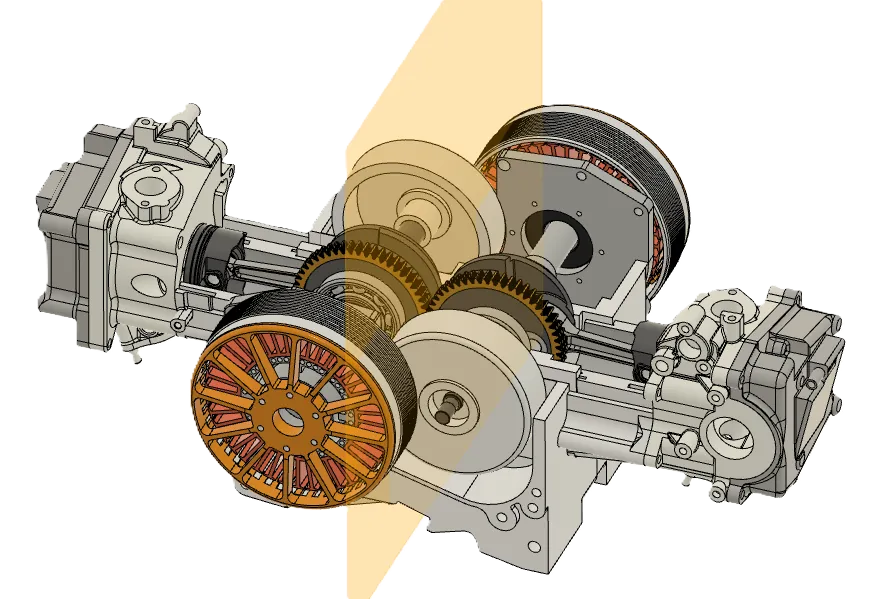
Our combustion engine featuring generators comprises of two single-cylinder engines arranged symmetrically in a single plane. The axes of these cylinders align along a single straight line. The crankshafts are housed within the block and are interlinked by gears with a gear ration of 1/-1, signifying opposite direction of rotation.
The first crankshaft is coupled to the first generator, while the second crankshaft is connect with the second generator or flywheel. It is critical to note the requirement for the moment of inertia of the first crankshaft assembly with generator must match the second crankshaft assembly with generator or flywheel. The cylinder axis are positioned perpendicular to the plane of symmetry, which resides between the crankshafts, and both pistons reach top dead center (TDC) simultaneously.
For more comprehensive details, you may refer to the patent files available on this website.
Elimination of the First Vibration Source
As previously mentioned, the first source of vibration stems from inertial forces engendered by the movement of crank mechanism components and their associated moments of force.
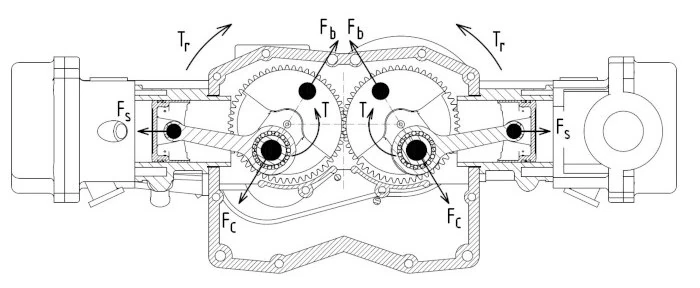
In our design, the individual crank mechanisms are balanced in such a manner that unbalanced rotary masses are counterbalanced 100%. This entails the complete cancellation of centrifugal forces (Fc + Fb = 0). While the sliding masses within the individual crank mechanisms remain unbalanced, their symmetrical design ensures that the accelerations of these sliding masses within each cylinder, at each time step, exhibit the same magnitude but opposite directions. Consequently, the inertial forces (Fs) arising from the sliding masses cancel each other out. This ensures the perfect elimination of all harmonic components associated with these inertial forces. As all sliding masses move along a single axis, no moment of force is generated by the inertial forces, provided the weights of all components in both crank mechanisms are equal.
This design comprehensively eliminates all harmonic components of inertial forces. By adhering to the aforementioned design criteria, we attain an ideal balance.
Elimination of the Second Vibration Sources
As highlighted in the “A Brief Examination of Vibration Challenges” section, the second source of vibrations results from the substantial torque fluctuation on the crankshaft during the combustion cycle, subsequently giving rise to reaction torque in the engine mount.
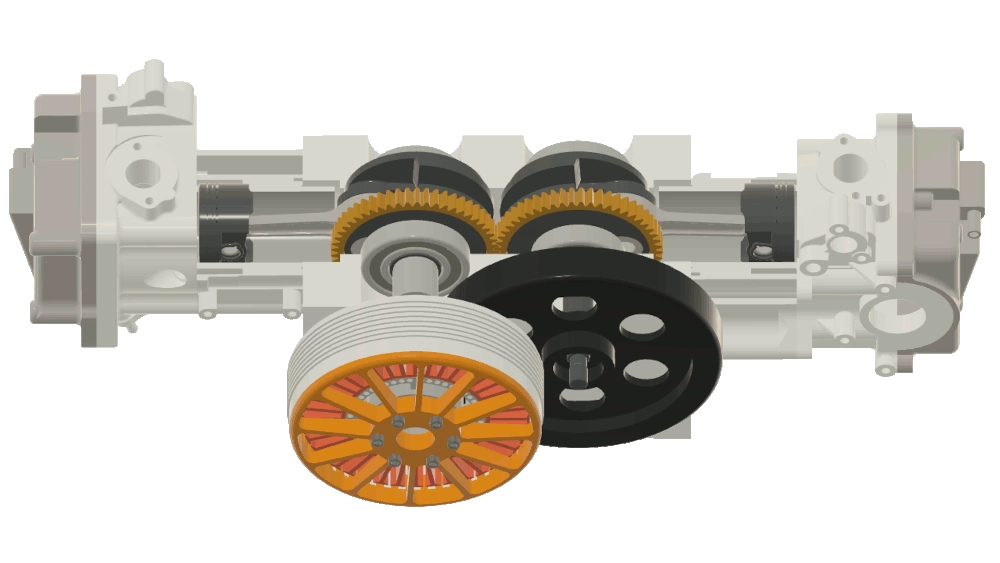
The Range extender we present adopts the aforementioned construction, featuring two crankshafts. These crankshafts rotate in opposite directions at identical speeds, and each set of crankshafts possesses identical moments of inertia. The synchronization between these crankshafts is maintained with precision, facilitated by gears. As a consequence, all angular accelerations exhibit the same magnitudes but in opposite directions.

This perfect synchronization effectively eradicates reaction moments (Mn) caused by torque irregularities on the crankshaft, stemming from the specifics of the combustion cycle. In instances where the mixture ignites simultaneously in both cylinders, the force (Fr) transmitted to the crank mechanism shares similar magnitudes. The near-identical forces acting on both crank mechanisms is transferred into minimal stress exerted on the synchronization gears.
This configuration offers distinct advantages. Using two smaller generators maintains the engine’s height while ensuring efficient power distribution. In situations where a single generator is preferred, it can operate in conjunction with a flywheel on the other crankshaft, with gears transfer only useful power. Even in this case, the synchronization gears are minimally loaded.
Importantly, the gear-driven coupling of crankshaft movements ensures consistent angular acceleration. Even if one cylinder experiences ignition failure, the machine’s balance remains intact. It’s worth noting that this situation may increase stress on the synchronization gears.
Advantages of the Solution
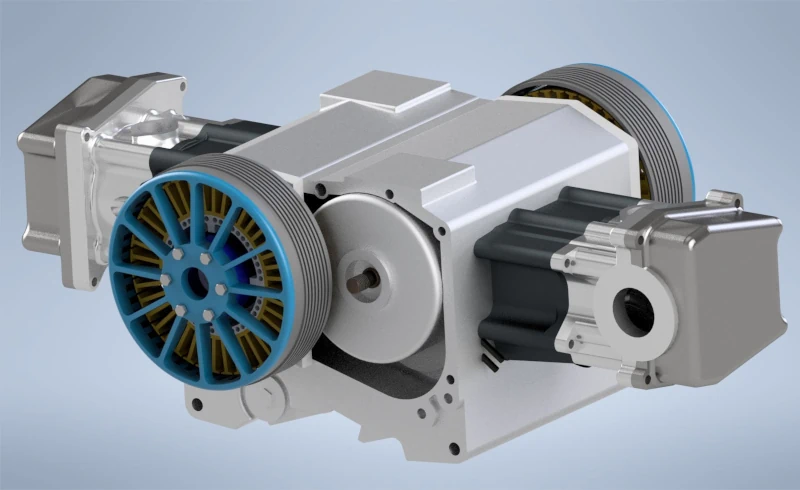
The Range extender solution we introduce exerts no fluctuating forces or moments on the motor mount. The system operates in a state of neutrality, impacting the engine mount solely through its weight. Consequently, this motor-generator experiences no vibrations during startup or shutdown and effectively eliminates vibrations across the entire speed spectrum.
The design’s elegance lies in its simplicity, devoid of the need for balancing shafts. Consequently, the gearing within the crank mechanism experiences minimal loads, a feature that augments the engine’s lightness and mechanical efficiency.
This design optimally harnesses components from contemporary single-cylinder engines, streamlining the development of a motor-generator for specific applications, a process that is rapid and cost-effective.
Our solution enables an exceptionally low installation height and compact installation length, rendering it suitable for installation within the floor or bumper of electric vehicles. In the context of aircraft, the streamlined design proves advantageous for the most common types of internal combustion engines employed.
Furthermore, it is perfect to consider a diesel version of the motor-generator, free from the challenges associated with rough running and accompanying vibrations. In aviation, the efficient combustion of kerosene could significantly reduce fire risks.
In our forthcoming article “Vibration simulation” we delve into the realm of vibration analysis, offering simulations that compare the vibration of standard two-cylinder internal combustion engines with our motor-generator in various configurations. Additionally, we touch upon some competitive solution in the field.
